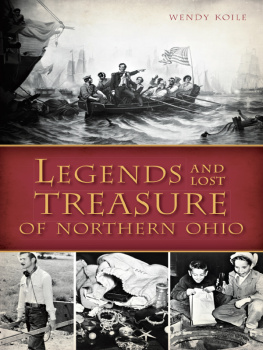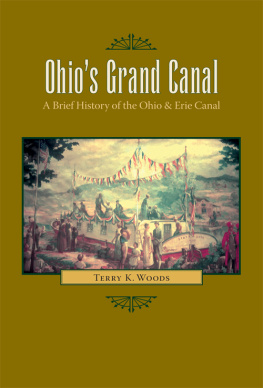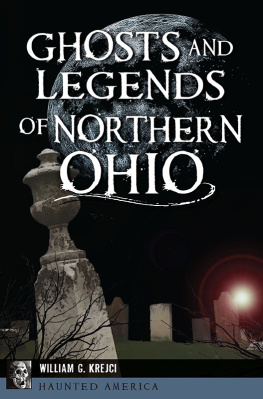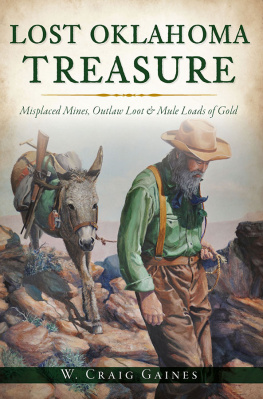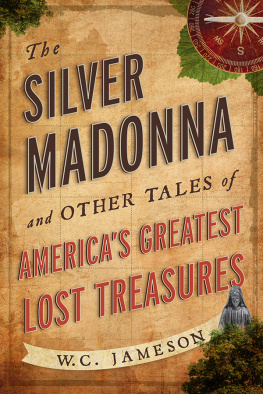

Published by The History Press
Charleston, SC 29403
www.historypress.net
Copyright 2014 by Wendy Koile
All rights reserved
First published 2014
e-book edition 2014
ISBN 978.1.62584.718.8
Library of Congress Cataloging-in-Publication Data
Koile, Wendy.
Legends of lost treasure in northern Ohio / Wendy Koile.
pages cm
Includes bibliographical references and index.
print edition ISBN 978-1-62619-240-9 (paperback)
1. Treasure troves--Ohio--History--Anecdotes. 2. Ohio--Antiquities--Anecdotes. 3. Ohio--History--Anecdotes. 4. Ohio--Social life and customs--Anecdotes. 5. Legends--Ohio. I. Title.
F491.6.K65 2014
977.101--dc23
2013047439
Notice: The information in this book is true and complete to the best of our knowledge. It is offered without guarantee on the part of the author or The History Press. The author and The History Press disclaim all liability in connection with the use of this book.
All rights reserved. No part of this book may be reproduced or transmitted in any form whatsoever without prior written permission from the publisher except in the case of brief quotations embodied in critical articles and reviews.
For Emma, my daughter. My favorite treasure of all.
CONTENTS
ACKNOWLEDGEMENTS
For several years, I have enjoyed reading books published by The History Press. I never dreamed that one day I would publish, not one, but two books with THP. I would like to give a heartfelt thanks to the THP team, especially my commissioning editor, Greg Dumias. You have all offered support, encouragement and expertise throughout the entire process. Without you, there would be no book.
Secondly, I would like to thank my family and closest friends. Each and every one of you stood by as I worked on my project, helping me through the I cant do this days and praising me through the Gonna write a book days. Your support is invaluable to me.
Thanks to my aunt Kathy for your enthusiasm and love. You have always been on my first to know list about all my lifes important events.
A special thanks to my dearest writer friend, Jane Turzillo. Thank you for always being just a text away whenever I needed you. Your friendship kept me going every day!
For all my research resources, Id like to thank Stephanie at Stark County Library, Genealogical Department; Judy at Stark County Historical Society; Bryon Scarbrough (a giant thanks); Rhonda Cookenour Turner; Louis Foster of Delaware; Jack Wade (favorite islander); hosts Ron and Sharon Rosengarten at House of Rose n Garden Bed-and-Breakfast; Roger Bartley (tour guide and info source); the folks at Minerva Area Historical Society; Henry County Library librarians; the Ashtabula County Library Reference Department; Scott Caputo at Columbus Metropolitan Library; and many more who offered information or retold the tales.
I would like to thank my family at Zane State Collegeboth colleagues and students. I am so glad to be part of a positive and encouraging work environment. Thank you all for that.
Most of all, I would like to thank God for the treasure of life.
INTRODUCTION
We are hunting pirates gold! exclaimed my daughter as she and my nephew vigorously worked under our old maple tree. In the recesses of my mind, I knew that digging a hole of such volume was probably not considered neat and tidy landscaping in our front yard. Yet I happily stood by while they worked. It was not that long ago when I had surveyed for treasure in my parents backyard with much the same passion.
As this book idea took shape in my mind, I pondered the concept of buried or lost treasure. Was it really possible in Ohio? After all, we are not an out west territory where outlaws rode off leaving hoards of gold buried in secret caves. Nor are we a coastal state, where pirates came ashore to bury their loot from recent plundering. Thus, what I knew about traditional tales of buried treasure suggested that Ohio was not a prime location for such legends.
However, I could not let the idea go. And then it hit me. Its not so much about actually finding a trunk of goldalthough that would certainly brighten my day a bit. Rather, the concept of the story, of how the treasure legends came to be in the first place, is the real treasure. And I have found that Ohioans, especially those of olden days, were not to be left out of such tales. Midwest farming state or not, we Ohioans do love a great local treasure tale when we hear one.
With this new idea in place, I began my research. What I have found is that almost every Ohio treasure tale started from truth and then grew into legend. Whether born from a bank robbery gone bad or a secretly rich hermit scurrying about, these characters of buried treasure tales did exist. If they left treasures hidden in secret locations, they are yet to be discovered for most of these tales. In the meantime, I propose we enjoy the intriguing life stories that have caused curious Ohioans so much speculation.
As my daughter and nephew continued their quest that afternoon, logic never did sink in. It didnt matter that pirates did not frequent our small town. As they continued the dig, they discussed the pirates and why they hid their treasure in our yard. It was a plausible dream to them. And the thrill was all in the tale, the possibility and, of course, the dirt.
Note: Unfortunately, the children did not find gold. However, they were delighted to find a dinosaur tooth that mysteriously resembled a small pebble.
Chapter 1
TELLING TALES
In the first nonfiction book written concerning lost treasure, Ralph Paine states that the dullest of imagination is apt to be kindled by any plausible dream of finding their treasure. Paine wrote his book at a time when much of the world was kindled by tales of treasure. The book Treasure Island by Robert Louis Stevenson had been released twenty-five years earlier and had grown to be an international bestseller.
Although written as a childrens book, Treasure Island was consumed by children and adults alike. To this day, the book remains one of the most beloved adventure stories of all time. Stevenson wrote that for if he has never been on a quest for buried treasure, it can be demonstrated that he has never been a child. The author capitalized on the notion that the common manhis readerhas most assuredly pondered the thrill of finding a lost treasure. Likewise, Mark Twain states that there comes a time in every rightly constructed boys life, when he has a raging desire to go somewhere and dig buried treasure.
In almost every culture, there exist tales of lost treasure. From the Australian Alps to the backwoods of West Virginia, secrets have been handed down for centuries. Patrick Mullen, folklore researcher, suggests that the tales themselves are symbolic of the American work ethic. He states that the fact that the legends are open-endedthey do not end like some legends domay indicate that they are standing invitations to Americans to dig and provide their own happy ending to the story.

Two young boys in Cleveland are delighted to find several coins after chasing a ball down the manhole. Authors collection.
Most treasure tales are presented as just thattales. However, with every tale, there is always an abundance of fact. The existence of treasure handlers, the historical context and even the wealth can be proved in almost every instance. Yet for some, an actual treasure would need to be dug up to prove its existence. For others, the facts leading up to the secret are enough. The love of a mystery, the thrill of the hunt and great imagination have kept most tales in circulation. Paine states that there are no conscious liars among the tellers of treasure tales. The spell is upon them. They believe their own yarns, and they prove their faith by back-breaking works with pick and shovel. Thus, the treasures, and their hunters, continue in the quest.
Next page
